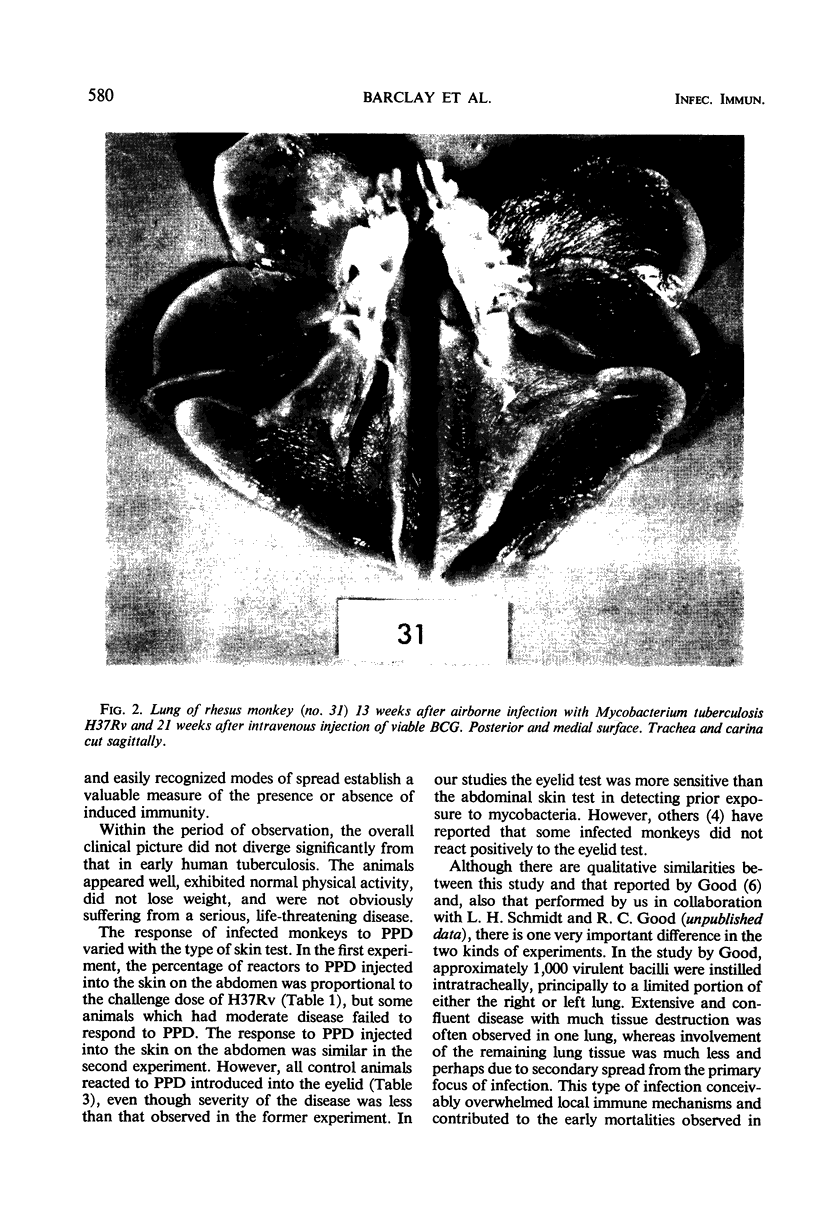Abstract
Suitability of the rhesus monkey (Macaca mulatta) as an experimental host for evaluation of vaccines against airborne infection with Mycobacterium tuberculosis strain H37Rv was investigated. Nonvaccinated monkeys were exposed to estimated doses of 12, 25, or 49 units of H37Rv in a modified Henderson apparatus, and the course of the disease was followed by chest X rays, skin testing with purified protein derivative, body-weight determinations, and autopsy 8 weeks postinfection. These animals developed progressive and extensive tuberculosis with pathological changes proportional to the infecting dose. Four of seven monkeys vaccinated intravenously with 1 mg of live BCG 8 weeks prior to challenge with 40 units of H37Rv had no gross evidence of disease at autopsy 13 weeks postinfection; the other three monkeys had minimal disease. These data demonstrated that (i) reproducible and progressive infection could be induced in rhesus monkeys infected in a manner which simulated natural infection of man and (ii) a high level of resistance to infection could be induced by BCG vaccine in the rhesus monkey, which in nature is highly susceptible to tuberculous infection.
Full text
PDF








Images in this article
Selected References
These references are in PubMed. This may not be the complete list of references from this article.
- Anacker R. L., Barclay W. R., Brehmer W., Goode G., List R. H., Ribi E., Tarmina D. F. Effectiveness of cell walls of Mycobacterium bovis strain BCG administered by various routes and in different adjuvants in protecting mice against airborne infection with Mycobacterium tuberculosis strain H37Rv. Am Rev Respir Dis. 1969 Feb;99(2):242–248. doi: 10.1164/arrd.1969.99.2.242. [DOI] [PubMed] [Google Scholar]
- BENSON R. E., FREMMING B. D., YOUNG R. J. A tuberculosis outbreak in a Macaca mulatta colony. Am Rev Tuberc. 1955 Aug;72(2):204–209. doi: 10.1164/artpd.1955.72.2.204. [DOI] [PubMed] [Google Scholar]
- Brehmer W., Anacker R. L., Ribi E. Immunogenicity of cell walls from various mycobacteria against airborne tuberculosis in mice. J Bacteriol. 1968 Jun;95(6):2000–2004. doi: 10.1128/jb.95.6.2000-2004.1968. [DOI] [PMC free article] [PubMed] [Google Scholar]
- Good R. C. Biology of the mycobacterioses. Simian tuberculosis: immunologic aspects. Ann N Y Acad Sci. 1968 Sep 5;154(1):200–213. doi: 10.1111/j.1749-6632.1968.tb16710.x. [DOI] [PubMed] [Google Scholar]
- Grover A. A., Kim H. K., Wiegeshaus E. H., Smith D. W. Host-parasite relationships in experimental airborne tuberculosis. II. Reproducible infection by means of an inoculum preserved at -70 C. J Bacteriol. 1967 Oct;94(4):832–835. doi: 10.1128/jb.94.4.832-835.1967. [DOI] [PMC free article] [PubMed] [Google Scholar]
- INNES J. R., COLTON M. W., YEVICH P. P., SMITH C. L. Lung mites; pulmonary acariasis as an enzootic disease caused by Pneumonyssus simicola in imported monkeys. Am J Pathol. 1954 Jul-Aug;30(4):813–835. [PMC free article] [PubMed] [Google Scholar]
- Larson C. L., Baker R. E., Baker M. B. Immunization of rabbits with viable BCG and nonliving cell wall vaccines. Am Rev Respir Dis. 1968 Dec;98(6):944–953. doi: 10.1164/arrd.1968.98.6.944. [DOI] [PubMed] [Google Scholar]
- Ribi E., Anacker R. L., Brehmer W., Goode G., Larson C. L., List R. H., Milner K. C., Wicht W. C. Factors influencing protection against experimental tuberculosis in mice by heat-stable cell wall vaccines. J Bacteriol. 1966 Oct;92(4):869–879. doi: 10.1128/jb.92.4.869-879.1966. [DOI] [PMC free article] [PubMed] [Google Scholar]
- Ribi E., Brehmer W., Milner K. Specificity of resistance to tuberculosis and to salmonellosis stimulated in mice by oil-treated cell walls. Proc Soc Exp Biol Med. 1967 Feb;124(2):408–413. doi: 10.3181/00379727-124-31752. [DOI] [PubMed] [Google Scholar]
- Schroeder C. R. Acquired Tuberculosis in the Primate in Laboratories and Zoölogical Collections. Am J Public Health Nations Health. 1938 Apr;28(4):469–475. doi: 10.2105/ajph.28.4.469. [DOI] [PMC free article] [PubMed] [Google Scholar]
- Smith D. W., Grover A. A., Wiegeshaus E. Nonliving immunogenic substances of Mycobacteria. Bibl Tuberc. 1968;24:191–227. [PubMed] [Google Scholar]
- WOLOCHOW H., CHATIGNY M., SPECK R. S. Studies on the experimental epidemiology of respiratory infections. VII. Apparatus for the exposure of monkeys to infectious aerosols. J Infect Dis. 1957 Jan-Feb;100(1):48–57. doi: 10.1093/infdis/100.1.48. [DOI] [PubMed] [Google Scholar]





